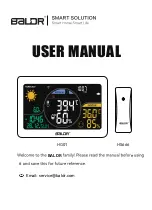
Installation Manual
3
As an example, consider a weather station sited in a crop of newly planted corn
with the anemometer 2m above the ground. The measured wind speed will
decrease markedly as the crop grows because the distance between the instrument
and the surface is continually reducing. At harvest the anemometer may be only 20
or 30cm above the upper foliage and the measured wind speed will be slow. This
is a true representation of conditions at the height of the anemometer; it is effec-
tively a microclimatic measurement that is not representative of the general
conditions in the region.
2.1 The Effects of Varying Environmental Conditions
This section describes three ways in which local conditions such as moisture or the
presence of vegetation can affect the measurements taken by a weather station.
These effects are well documented and further details can be found in the mete-
orological literature.
2.1.1 The Clothesline Effect
The ‘clothesline effect’ in its simplest form describes the effect of air passing from
dry, un-vegetated surfaces to moist, vegetated surfaces and the consequent effect
on vapour gradients and heat transfer. This should be carefully considered when
siting a weather station in crops or near trees when the wind direction is mostly
towards the vegetation.
2.1.2 The Leading Edge Effect
This effect occurs when air moves over a surface that differs in temperature,
moisture content, roughness or some other characteristic from an adjacent surface.
The line of discontinuity is known as the leading edge. As air passes over the
leading edge its characteristics gradually adjust to the new surface. This internal
boundary layer varies in vertical extent with distance from the leading edge. A
transitional zone exists where the air is modified but not adjusted to the new
surface. These effects become most pronounced when advection (horizontal air
flow) is strongest. There are no universally accepted figures for the height of this
internal boundary layer as it is influenced by the nature of the surface and the
extent of any advection.
2.1.3 The Oasis Effect
The ‘oasis effect’ occurs when an isolated moisture source is surrounded by an
otherwise arid region. If the wind direction is such that moist air is drawn from the
surface of the water body (or other water source such as a glacier or area of
vegetation), then the relative humidity measurements do not represent the general
conditions in the region.
2.2 Obstructions
Whenever possible, the weather station should be located away from windbreaks
or shelterbelts. Several zones have been identified upwind and downwind of a
windbreak in which the airflow is unrepresentative of the general speed and
direction. Eddies are generated in the lee of the windbreak and air is displaced
upwind of it. The height and depth of these affected zones varies with the height
and to some extent the density of the obstacle.
Generally, a structure disturbs the airflow in an upwind direction for a distance of
about twice the height of the structure, and in a downwind direction for a distance
of about six times the height. The airflow is also affected to a vertical distance of














































